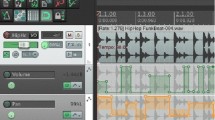Abstract
A virtual haptic-audio drawing program prototype designed for visually impaired children, has been gradually developed in a design-evaluation loop involving users in four stages. Three qualitative evaluations focused on recognizing drawn shapes and creating drawings have been conducted together with a reference group of 5 visually impaired children. Additionally, one formal pilot test involving 11 adult sighted users investigated the use of a combination of haptic and sound field feedback. In the latter test the relief type (positive and negative) was also varied. Results indicate a subjective preference as well as a shorter examination time for negative relief over positive relief for the interpretation of simple shapes such as 2D geometrical figures. The presence of the position sound field with a pitch and stereo panning analogy was not shown to affect task completion times.
Preview
Unable to display preview. Download preview PDF.
Similar content being viewed by others
References
Sjöström, Calle, Non-Visual Haptic Interaction Design - Guidelines and Applications. PhD Dept. for Design Sciences, Lund University, Faculty of Engineering (2002)
Yu, W., Brewster, S.A.: Comparing Two Haptic Interfaces for Multimodal Graph Rendering, Florida, USA (2002)
Yu, W., Kangas, K., Brewster, S.: Web-based haptic applications for blind people to create virtual graphs. In: Proceedings of the 11th Symposium on Haptic Interfaces for Virtual Environment and Teleoperator Systems, HAPTICS 2003. pp. 318–325 (2003)
Bussell, L.: Touch Tiles: Elementary Geometry Software with a Haptic and Auditory Interface for Visually Impaired Children, pp. 512–515 (2006) (2003)
Iglesias, R., Casado, S., Gutierrez, T., Barbero, J.I., Avizzano, C.A., Marcheschi, S., Bergamasco, M.: Computer graphics access for blind people through a haptic and audio virtual environment. In: Proceedings of the 3rd IEEE International Workshop on Haptic, Audio and Visual Environments and Their Applications, HAVE 2004, pp. 13–18 (2004)
Magnusson, C., Rassmus-Gröhn, K., Sjöström, C., Danielsson, H.: Navigation and Recognition in Complex Haptic Virtual Environments - Reports from an Extensive Study with Blind Users. In: Wall, S.A., Riedel, B., Crossan, A., McGee, M.R. (eds.), Edinburgh, UK (2002)
Magnusson, C., Rassmus-Gröhn, K.: Audio haptic tools for navigation in non visual environments, 11-17-0050 (2005)
Magnusson, C., Rassmus-Gröhn, K.: A Virtual Traffic Environment for People with Visual Impairments. Visual Impairment Research 7(1), 1–12 (2005)
Kennedy, J.M.: Drawing and the Blind - Pictures to Touch New Haven and London. Yale University Press (1993)
Art Beyond Sight Art Education for the Blind, Inc. AFB Press (2003)
Kamel, H.M.: The Integrated Communication 2 Draw (IC2D). Ph. D. Electrical Engineering and Computer Sciences Department, University of California (2003)
Hansson, C.: Haptic Drawing Program. Master Design Sciences, Lund University, Faculty of Engineering (2003)
Yu, W., Brewster, S., Ramloll, R., Ridel, B.: Exploring computer-generated line graphs through virtual touch. In: Sixth International Symposium on Signal Processing and its Applications 2001, vol. 1, pp. 72–75 (2001)
Sjöström, C., Danielsson, H., Magnusson, C., Rassmus-Gröhn, K.: Phantom-based haptic line graphics for blind persons. Visual Impairment Research 5(1), 13–32 (2003)
Riedel, B., Burton, A.M.: Perception of Gradient in Haptic Graphs by Sighted and Visually Impaired Subjects (2002)
Pakkanen, T., Raisamo, R.: Perception strategies in modal-redistributed interaction. In: Proceedings of the 31st Annual International Symposium on Computer Architecture, pp. 641–644 (2005)
Author information
Authors and Affiliations
Editor information
Editors and Affiliations
Rights and permissions
Copyright information
© 2006 Springer-Verlag Berlin Heidelberg
About this paper
Cite this paper
Rassmus-Gröhn, K., Magnusson, C., Eftring, H. (2006). User Evaluations of a Virtual Haptic-Audio Line Drawing Prototype. In: McGookin, D., Brewster, S. (eds) Haptic and Audio Interaction Design. HAID 2006. Lecture Notes in Computer Science, vol 4129. Springer, Berlin, Heidelberg. https://doi.org/10.1007/11821731_8
Download citation
DOI: https://doi.org/10.1007/11821731_8
Publisher Name: Springer, Berlin, Heidelberg
Print ISBN: 978-3-540-37595-1
Online ISBN: 978-3-540-37596-8
eBook Packages: Computer ScienceComputer Science (R0)




